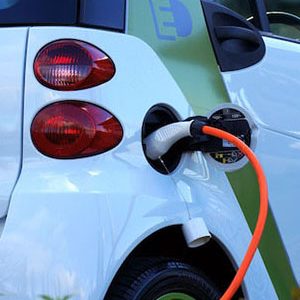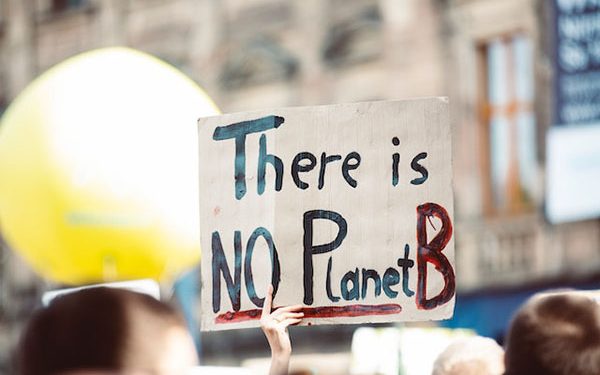The sustainability movement has emerged as a 21st century megatrend, and it shows no signs of abating. Record heat in Europe, wildfires in the U.S. West, floods in Pakistan, drought in China, and accelerating ice cap melt in Greenland and Antarctica have driven home to many the looming threat of climate change.
Meanwhile, the New York Times declared in December “the sustainable industrial revolution is just getting started,” and even heavy industries like shipping, steel, and plastics are beginning to grasp the importance of an ecologically sustainable future — developing products like “green steel,” which is a fossil-free steelmaking process.
But hurdles remain, including questions about transparency, accountability, traceability, trust, data integrity, and even greenwashing (making false or insincere environmental claims.) Or as the Times asked: “Can some of history’s highest-polluting industries be trusted?” in spite of their professed good intentions.
This is where blockchain technology could make a difference. Like the sustainability movement itself, blockchain tech is global, 21st century, and mostly unformed though likely to be shaped soon by new laws and rules. Blockchains can simplify and lower costs of ESG (environmental, social and governance) reporting, build trust in “collected” data, develop new eco-related trading markets, and suggest new sources of innovation.

In March, for instance, automaker Volkswagen announced that it was using blockchain technology to help ensure that electric vehicle (EV) charging stations were using sustainable sources to recharge their electric cars. This move is aimed at consumers who want validation that the energy being used to recharge their vehicles isn’t coming from brown coal-powered electric companies or the like. BMW is said to be developing something similar.
Elsewhere, energy giant Shell announced in June the launch of Avelia, a sustainable aviation fuel (SAF) solution for business travel. The project uses a public blockchain to promote and validate SAF, which can reduce lifecycle emissions by up to 80% compared to conventional jet fuel.
Many now foresee a blossoming partnership between environmentalists and blockchain developers, especially as Ethereum with its big Merge, as well as other networks, move closer to carbon zero and even carbon negative platforms.
“I continue to believe that putting Paris Agreement carbon markets on Ethereum and connecting the national carbon accounts of the world, is blockchain’s killer app,” Joseph Pallant, climate innovation director at Ecotrust Canada and founder and executive director of the Blockchain for Climate Foundation, tells Magazine.
But if this promise of a blockchain/ESG alliance is to reach fruition, some questions need to be resolved, including:
- Are public permissionless blockchains sufficiently scalable to handle the sheer amount of data to be tracked for sustainability use cases?
- Looking off-chain, do blockchain-based sustainability-related projects face an oracle problem? Who is going to attest, for example, that carbon offset credits entered on the blockchain are legitimate — and that they are really doing something beneficial for the environment?
- Finally, blockchain technology might be a useful tool in the quest to develop a global sustainable future, but is it a necessary one? Does the sustainability movement really need public blockchains to succeed?
We are pleased announce the launch of the “Pilot Project on Peer to Peer (#P2P) Trading of Rooftop #Solar Power on #Blockchain” in Lucknow, Uttar Pradesh ~The first of its kind project in #SouthAsia and #India
Tags: @rejipillai @UPPCLLKO @PowerLedger_io pic.twitter.com/iydmQz9cm1
— India Smart Grid Forum (@IndiaSmartGridF) December 17, 2020
Tokenizing for more efficient markets
Many think that blockchain tech can make ESG-related markets more efficient, including the rapidly growing Voluntary Carbon Market, or VCM, where parties voluntarily buy and sell carbon credits that represent certified carbon removals or reductions of greenhouse gasses (GHGs).
Corporations can purchase carbon credits to meet their carbon neutrality commitments. “A significant proportion of carbon credits issued this year have been minted on-chain,” Charlie Moore, head of Carbon and ESG Solutions at Chainlink Labs, tells Magazine, adding:
“The carbon credit market has historically been manual, slow, opaque, and inefficient. By moving carbon credit markets on-chain, the market inherently becomes automated, fast, transparent, and highly efficient.”
Globally, carbon dioxide (CO2) permits grew to $851 billion in 2021, a gain of 164% compared with the previous year, according to Refinitiv, with most trading taking place within the European Union.
But multiple challenges remain in scaling Web3 carbon markets, adds Moore, including the lack of market standards. “In addition, there are hundreds of layer-1 blockchains with little interoperability between them.”
The blockchain trilemma looms, too. In building networks, it’s commonly believed that developers must choose among three key benefits — decentralization, scalability and security. They can have two but not three. So a project can have decentralization and security, but not scalability. Or scalability and security, but not decentralization, etc.

Powerledger, for example, is an Australian company that uses blockchain technology to enable neighbors in India’s Uttar Pradesh state to trade solar energy on a P2P basis. Its secure network is able to process an impressive 50,000-plus transactions per second, the project’s founder and CEO Jemma Green tells Magazine. But Powerledger uses a permissioned network — not a public, decentralized one.
By comparison, Nori, an innovative carbon removal marketplace, has expanded using secure, decentralized platforms like Ethereum and more recently Polygon through creating and selling NRT tokens, each one representing one tonne of removed CO2 stored. The idea is that farmers are paid for adopting regenerative agricultural techniques — while other stakeholders, including consumers, can purchase tokens to reduce their carbon footprint.
Scaling up is still a challenge, however. “We can scale up the amount of supply/inventory that we have by further partnering with agriculture companies who can source large numbers of farmers for us,” Nori CEO Paul Gambill says, though “we’re sold out at the moment [in mid August] because the demand for carbon removal has outpaced the new supply enrollment.” Projects like these may take time to reach a global scale.
Beyond carbon removal
Carbon removal isn’t the only sustainability use case, of course. Indeed, a system like Nori’s which uses two assets—an NRT as a reference token, and NORI as medium of exchange token — could arguably be used in other ecological contexts, like ocean plastic recycling in the developing world.

“Yes, I would love to see this two-asset model adopted in other social impact areas,” Gambill says. “Another intractable problem is wildfires that grow to such huge sizes because of low brush and debris on the ground that acts as kindling. It should be possible to incentivize removal of that in a similar manner. Ocean plastic is also applicable.”
Blockchain technology can also help to alleviate a water shortage in parts of the U.S., where water is being diverted away from lakes, reservoirs, and rivers at unsustainable rates, says January Walker, a U.S. Congressional candidate in Utah. “Often there is no accountability as to where it goes,” she tells Magazine:
“Blockchain distributed ledger technology can be combined with IoT water parameter monitoring to track where the water is going, who is using the most, and provide a means of collaboration across state lines to drastically reduce water usage.”
“The sustainability movement needs to harness the power of frontier technologies like blockchain to help reach its goals in a faster and more efficient way,” Amna Usman Chaudhry, a founding member of the Oxford Blockchain Foundation tells Magazine. Blockchain offers various advantages such as increased transparency, security, immutability, and decentralization which can be utilized to find new innovative solutions to age old problems, including plastic pollution, particularly in oceans.
“Similarly Blockchain offers immense potential for sustainability for smart cities, such as is the case with Dubai, which through its implementation of the Dubai Blockchain Strategy aims to save USD $3 billion in operational costs, 398 million printed documents per annum and 77 million work hours annually,” Chaudhry adds.

Volkswagen’s EV pilot: Pick your energy source
Then there’s Volkswagen’s smart-charging electric vehicle (EV) pilot project which enables car owners to specify their favored source of energy. Drivers pulling into charging stations can “select to charge using wind and solar resources, from energy assets within a 10 km radius […] with an accurate breakdown of their session’s carbon footprint,” says project partner Jesse Morris, CEO at Energy Web, a firm that claims to have built first enterprise-grade, public blockchain tailored to the energy sector.
An algorithm determines the optimal charging schedule to maximize usage of clean, locally sourced electricity, while a smart-contract deployed on Energy Web’s network issues to the EV owner after charging an ERC1888 NFT, a fractionalized renewable energy certificate that proves the provenance and volume of clean electricity generated and consumed. VW’s innovation group is now working out how to roll this out at production scale.
A ‘huge catalyst’ for renewal energy
Solutions like these can help solve the sustainability movement’s greenwashing problem. “Some are skeptical that EVs are really carbon neutral given that they require recharging from electric sources that as far as they know could be generated by brown coal,” Anthony Day, global head of ecosystem stewardship at Parity Technologies, commented in a recent LinkedIn post.
This is consistent with Web3 project designs that, generally speaking, seek to make owners out of users and users out of owners. The EV is generating information all the time for the grid — temperature, traffic conditions, and so on, Day tells Magazine. “Your vehicle becomes an oracle. It could be identifying potholes on the road.”
Solutions like VW’s will also be of interest to businesses that own fleets of cars and need to document the carbon footprint of their vehicles, especially in Europe. “If you can show that your vehicles are topped up on fully renewable energy, that’s a major contribution” toward reducing a business’s carbon footprint, Day adds.
A boost from U.S. legislation?
The U.S. Inflation Reduction Act (IRA), signed into law in August, has earmarked $370 billion for the fight against climate change. Could the legislation indirectly spur blockchain adoption? “Blockchain technology will provide an immense boost to the impact of climate-related investments embedded in the Inflation Reduction Act,” Pallant tells Magazine. On-chain carbon pricing tools can help ensure that the most capital efficient climate solutions are selected in future projects, as well as providing the “needed transparency for verifying the ultimate impacts of this third of a trillion dollar spend.”
Not all agree, however, that the U.S. legislation will do much for blockchain adoption. “Having read through the IRA, I believe that it is unlikely to boost the utilization of blockchain as it does not make specific suggestions to lean into the technology,” says Walker.
To make a difference, blockchain would need a “champion” on every project being funded. “The only portion of the bill that I think would even help is the $4 billion for a water project. That however will go mostly to research and replacing a few 90-year-old pipes across the nation instead of innovating water technology and tracking,” adds Walker.

Is it really helping the planet?
It needs to be remembered, too, that blockchain technology has inherent limitations, and by itself “blockchain won’t save the world,” according to Day, who has a podcast by that title. Before ESG-related projects can be tokenized, someone or group needs to verify that the projects exist, they are useful for the environment and that they wouldn’t have happened without tokenized funds — they must have ‘additionality,’ in other words. The human factor can’t be finessed. “The sad fact of life is that the more manual you make that verification, the less scalable the system is,” says Day.
Verification in carbon markets is typically done by third parties based on standards developed by offset registries like Verra and Gold Standard. Recent efforts to meld blockchain with the registry process hasn’t gone smoothly. Earlier this year, for instance, crypto firms Toucan Protocol and KlimaDAO were criticized for promoting “cheap, low-quality carbon credits that don’t actually help the environment,” according to Bloomberg.
Indeed, a recent analysis by non-profit research organization CarbonPlan found that over 99.9% of Toucan’s BCT reference token came from CORSIA-ineligible credits, “i.e., the low-quality end of the carbon market,” Danny Cullenward, policy director at CarbonPlan, tells Magazine, including “zombie projects” like Dayingjiang-3, a Chinese hydropower dam project that has been operating since 2006. Credits from existing dams don’t do much to help the environment, many people argue.
“Even if the registries are the most culpable actors,” Cullenward continues, “Toucan, Klima, and other tokenization efforts point to registry standards as proof of quality. Anyone who is professionally engaged in these areas either knows or should know about the underlying quality control problems that remain, so I don’t have any patience for what effectively amounts to passing the buck.”
In response to the Bloomberg story that raised similar concerns, KlimaDAO published in April a letter-to-the-editor response, which acknowledged the problem on the “supply side” regarding the “quality and integrity” of carbon credits in the Voluntary Carbon Market (VCM), but it also noted that “the article fails to consider the widely accepted need to scale up the VCM to meet the emissions reduction targets prescribed by the Paris Climate Accord.”
To avoid the worst effects of climate change, according to the Taskforce on Scaling Voluntary Carbon Markets, “the volume of the VCM will need to grow by up to 15 times by 2030,” wrote Natacha Rousseau.
Other veterans of carbon markets like Pallant stand by Toucan and KlimaDAO, even after their BCT and KLIMA tokens plunged in price this year — KlimaDAO’s by 99% — and Verra announced that it was prohibiting the practice of creating tokens based on retired carbon credits.
“Klima’s price collapse mirrored […] the crash in crypto prices” generally, Pallant tells Magazine. “I think the actual story is how crazy it was that KlimaDAO’s price got so high, rather than that it has gone low. I don’t think anyone at KLIMA expected the price to go to $3,000 plus.” Shortly after its October 2021 launch, Klima soared over $3,600. It was trading at $3.84 in early September, according to CoinGecko.

Toucan, for its part, acknowledges that “many of the criticisms around the tokenization of dormant credits were valid,” John Hoopes IV, strategy and ecosystem at Toucan Protocol, tells Magazine, while Toucan is developing technologies to improve the quality and integrity of the VCM, including “a system to store the digital monitoring, reporting and verification [dMRV] data that will underpin many credit types.” As for the problem of dormant credits:
“We also introduced a rule to prevent carbon credits issued more than 10 years after emission reductions have taken place from using our technology and be converted into a carbon-backed token.”
Day isn’t giving up on tokenizing carbon credits, either. “I think it has a significant potential to be one of the largest blockchain use cases. “Global climate initiatives often struggle because of local regulation. What is accepted in Argentina may be different from what is accepted in France,” says Day. With a standardized token anybody can participate in that system — purchase, trade, invest. “You can get liquidity into that system. That’s very powerful if those token standards are recognized.”
As with many new technologies, a certain amount of patience may be required. “Both crypto and carbon are pretty complex and difficult — and when you put them together, it’s like difficulty squared,” Ollie Gough, strategy lead for the carbon-rating startup Sylvera, tells Time. “Mistakes have been made—and we’re waiting to see how it pans out.”
Is blockchain tech a ‘must have’?
Is blockchain technology really essential for the sustainability movement, though? “We see blockchain as something akin to using barcodes in supermarkets,” Powerledger’s Green says. “Barcodes and scanners are now integral to a supermarket. […] they facilitate supermarkets operating at high volumes and low margins.”
“Could supermarkets have taken off without barcode technology?” continues Green. “The answer is ‘probably,’ but at a much slower pace, because the high volume, low margin [success] is hard to achieve with just a manual input of prices into a till.”
The best of blockchain, every Tuesday
Subscribe for thoughtful explorations and leisurely reads from Magazine.
By subscribing you agree to our Terms of Service and Privacy Policy
New areas may emerge. “ESG investing is yet to embrace smart contracts at any real scale,” says Chainlink’s Moore. “There is enormous potential for smart contracts and blockchains to transform areas such as green bonds through tamper-proof automation.”
With the European Council and European Parliament’s recently agreed-upon rules for corporate sustainability reporting, nearly 50,000 EU companies in coming years will have to report ESG data, up from a mere 11,600 firms at present, according to EY. Blockchain technology could potentially make those filings more accessible, transparent, and credible for citizens, consumers and investors, many believe.
“I’m generally very bullish on future blockchain use cases, especially in the sustainability space,” Nori’s Gambill tells Magazine, while Pallant adds that “We’ve seen an absolute flood of new minds, talent and capital flow into the ReFi [regenerative finance] space over the last year. Well thought out, successful projects in that space will deliver profound value to climate, nature, forests, and seas by leveraging blockchain to deliver credible environmental assets.”





Leave a Reply